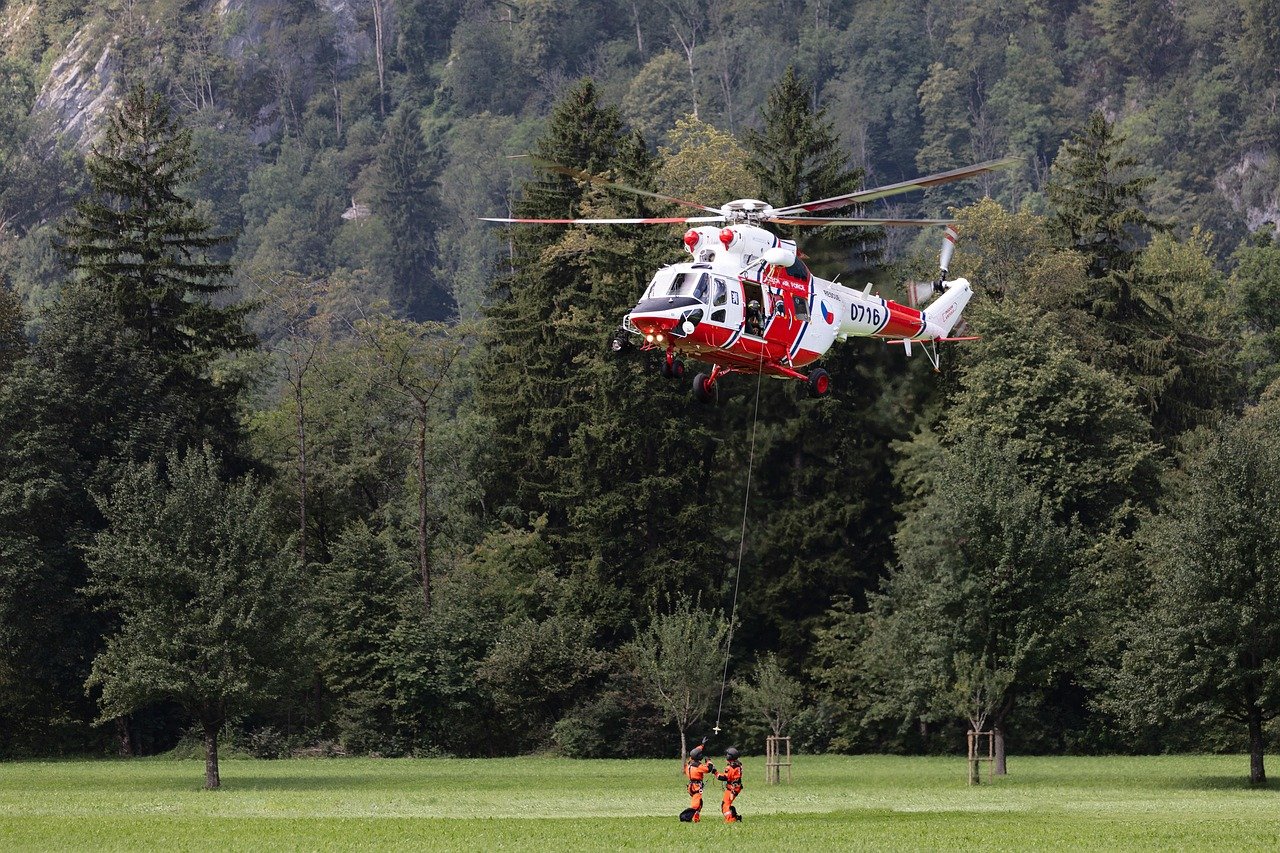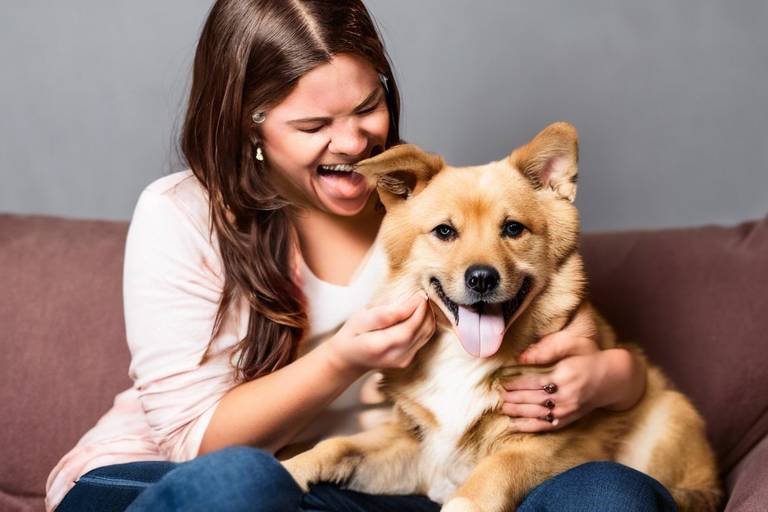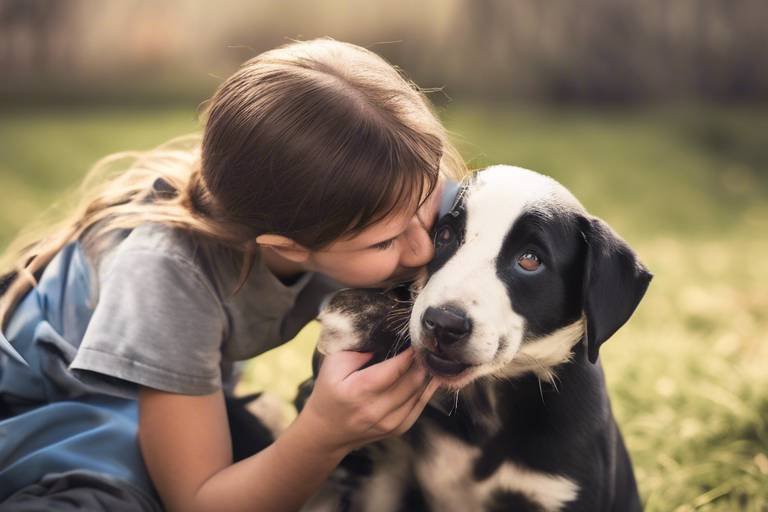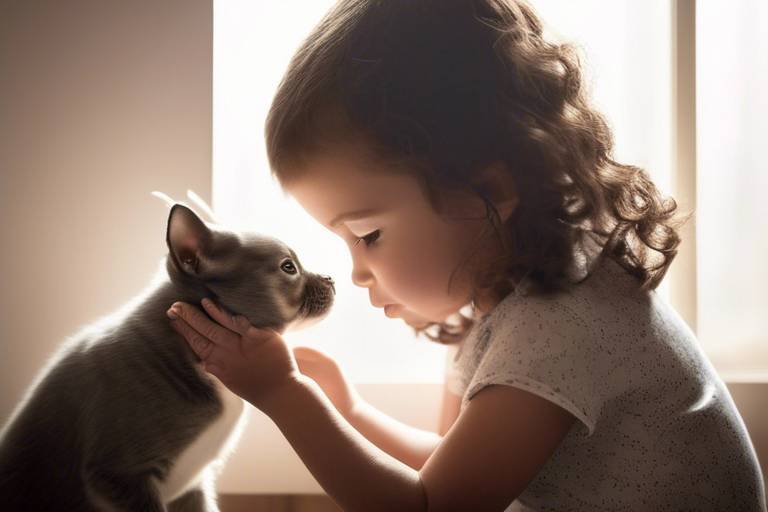How to Build Trust with Your Rescue Pet
Bringing a rescue pet into your home is like opening a new chapter in your life, full of potential and promise. However, it's essential to understand that these furry companions often come with a history that may affect their behavior and trust levels. Building trust with your rescue pet is not just about love; it’s about understanding, patience, and creating a safe environment where they can thrive. In this article, we’ll explore effective strategies to enhance the bond between you and your new friend, ensuring a happier and healthier relationship.
Before you can truly connect with your rescue pet, it’s vital to learn about their past. Many rescue animals have experienced trauma, neglect, or abandonment, which can manifest in various behaviors. By understanding their background, you can approach them with the empathy and patience they deserve. For instance, if a dog was previously abused, they might flinch at sudden movements or loud noises. Recognizing these signs allows you to tailor your approach, helping to foster a trusting relationship.
Establishing a secure space for your rescue pet is crucial for building trust. A welcoming atmosphere can significantly impact their comfort level and willingness to bond with you. Here are some key aspects to consider:
Selecting the ideal area in your home for your pet can make a significant difference in their comfort level. Look for a quiet corner where they can observe their surroundings without feeling overwhelmed. Factors such as noise, accessibility, and personal space should guide your decision. A cozy nook with their bed and toys can become their sanctuary, promoting relaxation and security.
Identifying and reducing potential stressors in your pet's environment can help them feel more at ease. This includes:
- Managing loud noises, such as vacuum cleaners or fireworks.
- Eliminating unfamiliar scents that may cause anxiety.
- Avoiding sudden movements that could startle them.
By creating a calm environment, you allow your rescue pet to feel safe and secure, which is fundamental for trust-building.
Creating a designated area with your pet's bed, toys, and blankets can offer them a sense of security and ownership. This personal sanctuary encourages them to explore and relax at their own pace. The more comfortable they feel in their space, the more likely they will open up to you.
Consistency is key to building trust with your rescue pet. A predictable daily routine can help them feel secure and understand what to expect from their new home. Consider incorporating regular feeding times, walks, and play sessions into your daily schedule. This structure not only helps your pet feel safe but also reinforces your role as their caregiver.
Utilizing positive reinforcement methods can significantly enhance your bond with your rescue pet. Instead of focusing on negative behaviors, reward good actions to encourage trust and cooperation. Here are some effective strategies:
Incorporating treats and rewards into training sessions can motivate your pet and reinforce positive behaviors. When they perform a desired action, such as sitting or coming when called, offer them a treat or verbal praise. This not only builds trust but also makes training a fun and rewarding experience for both of you.
Engaging in training exercises can boost your rescue pet's confidence and strengthen your relationship. As they learn to rely on you for guidance and support, their trust in you will grow. Start with simple commands and gradually introduce more complex tasks. Remember, patience is vital; every small achievement is a step towards a stronger bond.
Building trust takes time, especially with rescue pets who may have experienced trauma. It's essential to be patient and understanding throughout the bonding process. Each day is an opportunity to learn more about your pet and their needs.
Being able to identify signs of fear or anxiety in your pet is crucial. Common indicators include:
- Hiding or seeking solitude.
- Excessive barking or growling.
- Shaking or cowering.
This knowledge allows you to adjust your approach and provide the support they need, fostering a trusting relationship.
Acknowledging and celebrating small milestones in your pet's progress can motivate both you and your pet. Whether it’s a successful training session or your pet approaching you for affection, these victories are worth celebrating. They reinforce the trust you are building together, creating a positive feedback loop that encourages further progress.
Q: How long does it take to build trust with a rescue pet?
A: The timeline varies depending on the pet's background and personality. Some may take weeks, while others could take months. Patience is key.
Q: What should I do if my rescue pet shows signs of aggression?
A: It’s essential to consult a professional trainer or behaviorist. They can provide tailored strategies to help your pet feel more secure.
Q: Can I speed up the trust-building process?
A: While you can encourage trust through positive reinforcement and a safe environment, remember that every pet is unique. Respect their pace.

Understanding Your Rescue Pet's Background
When you bring a rescue pet into your home, you're not just gaining a new furry friend; you're also welcoming a creature that may carry the weight of past experiences. Understanding your rescue pet's background is crucial to building a trusting relationship. Each pet comes with its own story, often filled with challenges and hardships that can shape their behavior and personality. By taking the time to learn about their past, you can approach them with the empathy and patience they deserve.
Many rescue pets have encountered situations that could leave them feeling anxious or fearful. For instance, a dog that has been abandoned may be wary of new people or environments, while a cat that has lived on the streets might be hesitant to trust humans. Recognizing these factors is essential to creating a supportive atmosphere for your new companion. You might wonder, "How can I find out about my pet's history?" Here are a few tips:
- Ask the Rescue Organization: Most shelters or rescue groups will provide you with any information they have about your pet's background. This can include their previous living conditions, health issues, and behavioral traits.
- Observe Behavior: Pay attention to how your pet reacts to different situations. For example, if your dog flinches at loud noises, it might indicate a history of trauma related to sound.
- Consult with a Veterinarian: A vet can help you understand any medical issues or behavioral concerns that may stem from your pet's past, guiding you on how to address them effectively.
Understanding your pet's background is not just about knowing their history; it's about using that knowledge to foster a deeper connection. For instance, if you discover that your dog was abused, you can tailor your approach to be more gentle and reassuring. Similarly, if your cat was a stray, you might need to give them extra time to adjust to indoor life. Each pet is unique, and recognizing their individual needs will help you build trust.
Moreover, remembering that trust is built over time is crucial. Just like humans, animals need to feel safe and secure in their environment. The more you learn about your pet's past, the better equipped you'll be to create a nurturing space where they can thrive. By being patient and understanding, you can help your rescue pet heal from their past traumas and build a loving, lasting bond.
In conclusion, understanding your rescue pet's background is a vital first step in establishing a trusting relationship. It allows you to empathize with their experiences and tailor your approach to meet their needs. So, take the time to delve into their history, observe their behavior, and consult with professionals. This knowledge will not only enhance your bond but will also pave the way for a happier, healthier life together.

Creating a Safe and Comfortable Environment
Establishing a safe and comfortable environment for your rescue pet is not just a luxury; it's a necessity. Imagine moving into a new house where everything is unfamiliar. The walls are painted strange colors, the sounds echo in ways you’re not used to, and there are corners you simply can’t explore because you don’t know what’s lurking there. Your rescue pet feels exactly this way when they enter your home. By creating a welcoming atmosphere, you can help them feel more relaxed and secure, which is the first step in building that all-important trust.
First off, you need to choose the right space in your home for your furry friend. Think about it: if you were trying to find a spot to unwind after a long day, you wouldn’t want to be in a bustling area with constant noise and foot traffic. Your pet deserves a quiet corner where they can feel safe. Look for a space that is away from the hustle and bustle of the household, perhaps a cozy nook in your living room or a quiet corner of your bedroom. Consider factors like accessibility—can your pet easily get to their space? And personal space—do they have enough room to stretch out and relax?
Next, let’s dive into minimizing stressors. Just like humans, pets can be sensitive to their environment. Loud noises, unfamiliar scents, and sudden movements can send them into a tailspin of anxiety. To create a peaceful haven, identify potential stressors in your living space and take steps to reduce them. This could mean keeping the TV volume down, using air purifiers to control scents, or simply being mindful of how quickly you move around them. The goal is to create a sanctuary where your pet can feel at ease.
One effective way to enhance your pet’s sense of security is by providing them with a personal sanctuary. This is not just a bed in the corner; it’s a space filled with their favorite things. Think of it as their own little kingdom. Fill it with a soft bed, their favorite toys, and a blanket that smells like you. This gives them a sense of ownership and helps them understand that they are indeed home. When they have a designated area to retreat to, they are more likely to explore their new environment at their own pace, building their confidence and trust in you.
Another crucial element in creating a safe environment is establishing a routine. Pets thrive on predictability. Imagine waking up every day not knowing what to expect—wouldn’t that be stressful? By setting a consistent daily routine for feeding, walks, and playtime, you help your rescue pet understand what to expect from their new life with you. This not only reassures them but also strengthens your bond. They learn to rely on you, knowing that you will take care of their needs. Over time, this consistency will foster a sense of security and trust.
- How long does it take for a rescue pet to adjust to a new home? Every pet is different, but it can take anywhere from a few days to several weeks for them to adjust. Patience is key!
- What should I do if my rescue pet shows signs of fear? It's essential to recognize signs of fear and adjust your approach. Provide comfort, speak softly, and give them space when needed.
- Can I use training to help my rescue pet feel more secure? Absolutely! Positive reinforcement training can build their confidence and help them trust you more.
Choosing the Right Space
When it comes to welcoming a rescue pet into your home, one of the most crucial decisions you’ll make is choosing the right space for them. Think of this space as their personal haven—a place where they can feel safe, relaxed, and free to express themselves. Just like we all have our favorite spots in the house where we unwind after a long day, your furry friend deserves a special corner that caters to their needs.
First and foremost, consider the noise level in different areas of your home. Rescue pets, especially those who have experienced trauma, can be sensitive to loud sounds. A quieter room, away from the hustle and bustle of daily activities, can make a world of difference. Imagine trying to relax while a vacuum cleaner roars nearby! By providing a serene environment, you’re helping your pet feel more at ease.
Next, think about accessibility. Your rescue pet may have mobility issues or simply prefer a space where they can easily come and go. A cozy corner near the family room or a bedroom can be ideal, allowing them to feel included in family activities yet still retreat to their safe space when they need a break. It’s like having a comfy chair in a busy café—perfect for people-watching, but also a retreat when you need some peace.
Lastly, don’t forget about personal space. Just as we all cherish our own personal bubble, pets do too! Ensure that the area you choose is large enough for them to stretch out comfortably. You might even want to set up a small table or shelf nearby for their toys and treats, creating a little sanctuary that feels like theirs alone. This sense of ownership can significantly boost their confidence and help them settle in faster.
To sum it up, here are some key factors to keep in mind when choosing the right space for your rescue pet:
- Noise Level: Choose a quiet area to minimize stress.
- Accessibility: Ensure they can easily move in and out of their space.
- Personal Space: Provide enough room for them to feel comfortable and secure.
By thoughtfully selecting a space that meets these criteria, you’re laying the groundwork for a trusting relationship with your new furry friend. Remember, this is just the beginning of your journey together, and creating a welcoming atmosphere is the first step towards building a lasting bond.
Minimizing Stressors
When bringing a rescue pet into your home, one of the most crucial steps in building trust is in their environment. Just like humans, pets can feel overwhelmed by certain stimuli, which can hinder their ability to relax and bond with you. Understanding what might stress your furry friend is essential for creating a peaceful home. Start by observing their reactions to various sounds and sights around your house. For instance, loud noises such as thunder or fireworks can be particularly frightening for pets, especially those with a traumatic past.
To effectively minimize these stressors, consider the following strategies:
- Soundproofing Your Home: If you live in a noisy area, consider adding soft furnishings like rugs and curtains that can help absorb sound. You might also want to create a quiet space in your home where your pet can retreat during particularly loud events.
- Familiar Scents: Pets are highly sensitive to scents. Introducing familiar and calming scents, such as lavender or chamomile, can help create a soothing atmosphere. You can use essential oil diffusers, but make sure they are pet-safe!
- Controlled Movements: Sudden movements can startle your rescue pet. It’s important to approach your pet slowly and calmly, especially when you’re trying to engage with them. This gives them the chance to feel safe and secure.
Additionally, consider the layout of your home. Is there a lot of foot traffic in certain areas? If so, it might be beneficial to create a designated safe zone for your pet where they can retreat when feeling overwhelmed. This space should be free from sudden movements and loud noises, allowing them to decompress. Including their favorite toys, blankets, and even a cozy bed in this area can help them feel more secure.
Lastly, don’t forget to monitor your own energy. Animals are incredibly perceptive and can pick up on their human's emotions. If you’re feeling anxious or stressed, your pet may mirror those feelings. By maintaining a calm demeanor, you not only help your rescue pet feel safe but also create an environment where trust can flourish.
Q: How long does it take for a rescue pet to feel comfortable in a new home?
A: Every pet is different, but it can take anywhere from a few days to several weeks for a rescue pet to adjust. Patience is key!
Q: What are some signs that my pet is stressed?
A: Common signs of stress in pets include hiding, excessive barking or meowing, loss of appetite, and destructive behavior. Observing your pet closely will help you identify when they're feeling anxious.
Q: Should I use calming products for my rescue pet?
A: Yes, calming products like pheromone diffusers or anxiety wraps can help some pets feel more secure. Always consult with your vet to find the best options for your furry friend.
Providing a Personal Sanctuary
Creating a personal sanctuary for your rescue pet is not just a nice touch; it's a vital step in helping them feel secure and at home. Think of it as their very own safe haven, a cozy nook where they can retreat to recharge and feel protected from the outside world. This space should be a reflection of their needs and preferences, where they can engage in their natural behaviors without the stress of unfamiliar surroundings.
To start, choose a quiet corner of your home that is away from the hustle and bustle of daily life. This could be a spot in a bedroom, a cozy nook in the living room, or even a dedicated area in your basement. The key is to ensure that it’s a place where your pet can feel isolated from loud noises and sudden movements, which can be particularly unsettling for rescue pets who might be sensitive to their environment.
Within this sanctuary, consider adding items that bring comfort and joy to your pet. A soft bed is essential—choose one that is plush and inviting, allowing them to sink into comfort. You might also want to include:
- Toys: Select a variety of toys that encourage play and mental stimulation, such as chew toys, puzzle feeders, or soft plush toys.
- Blankets: A familiar blanket can provide both warmth and a sense of security, especially if it carries their scent or the scent of their previous home.
- Personal Items: Incorporate items that they might have had in their previous environment, like a favorite toy or a piece of clothing from their former owner, to help them feel more at ease.
Moreover, it’s crucial to ensure that this space is easily accessible for your pet. Consider their physical abilities; a senior pet or one with mobility issues might require a low bed or ramps to access their sanctuary comfortably. The goal is to make it as inviting and accommodating as possible so that your furry friend feels encouraged to explore and settle in.
Finally, it’s important to allow your pet to claim this space as their own. Avoid forcing them to stay there; instead, let them discover it at their own pace. You might even want to spend time in the sanctuary with them, engaging in gentle play or simply relaxing together. This not only helps them feel more comfortable but also strengthens the bond between you two. Remember, building trust takes time, and a personal sanctuary can be a significant step in that journey.
Q: How do I know if my pet is comfortable in their sanctuary?
A: Look for signs such as your pet willingly spending time there, playing with toys, or curling up in their bed. If they seem relaxed and happy, you’ve created a successful sanctuary!
Q: Can I change the location of the sanctuary later?
A: Yes, you can! Just be sure to introduce the new space gradually and allow your pet to adjust at their own pace.
Q: What if my pet doesn’t want to use the sanctuary?
A: It’s essential to be patient. Try adding their favorite items or spending time with them in the space to encourage them to explore it. It may take a while for them to feel comfortable.
Establishing a Routine
When it comes to building trust with your rescue pet, establishing a consistent routine is like laying down a solid foundation for a house. Just as a well-constructed home provides shelter and security, a predictable daily schedule can offer your furry friend a sense of stability and safety. Imagine how comforting it is to know what to expect each day; your pet craves that same reassurance. By incorporating a routine, you create a rhythm that allows your pet to feel more secure in their new environment.
Start by setting regular times for feeding, walks, and playtime. This consistency not only helps your pet adjust but also enhances their understanding of their new life with you. For example, if you feed your pet at 8 AM every morning, they will begin to anticipate mealtime, which can significantly reduce anxiety. You might even notice them waiting by their food bowl, tail wagging in eager anticipation. Additionally, incorporating playtime into your routine can serve as a bonding experience, allowing your pet to associate you with fun and joy.
Consider also creating a daily schedule that looks something like this:
| Time | Activity |
|---|---|
| 7:30 AM | Morning Walk |
| 8:00 AM | Feeding Time |
| 10:00 AM | Playtime |
| 1:00 PM | Afternoon Nap |
| 5:00 PM | Evening Walk |
| 6:00 PM | Feeding Time |
| 8:00 PM | Wind Down & Cuddle Time |
As you establish this routine, keep in mind that your rescue pet is still adjusting to their new surroundings. Be flexible and ready to adapt when necessary. For instance, if your pet seems particularly anxious during certain activities, you might want to modify the routine to provide more comfort. Remember, the goal is to foster a trusting relationship where your pet feels safe and understood.
In addition, try to incorporate quiet time into your routine. Just like humans, pets need moments to relax and recharge. Creating a calm environment during these times can help your pet feel more at ease. You could set up a cozy spot with their favorite blanket and toys, where they can retreat when they need a break. This sanctuary not only supports their emotional well-being but also reinforces the bond you are building together.
Ultimately, patience is key. It may take time for your rescue pet to fully embrace the routine, but with consistency and love, they will begin to thrive. As they settle in, you’ll notice their confidence growing, and your relationship will deepen. So, take a deep breath, enjoy the process, and watch as your furry friend flourishes in their new home!
- How long does it take for a rescue pet to adjust to a new routine? Every pet is different, but with consistency, many pets start to feel comfortable within a few weeks.
- What should I do if my pet resists the routine? Be patient and flexible. Adjust the routine as needed and give your pet time to adapt.
- Can I change the routine once my pet gets used to it? Yes! As your pet becomes more comfortable, you can gradually introduce new activities or change the schedule.

Positive Reinforcement Techniques
Building a strong bond with your rescue pet is not just about providing food and shelter; it’s about creating a relationship based on trust and understanding. One of the most effective ways to foster this connection is through . These methods focus on rewarding desired behaviors rather than punishing unwanted ones, which can lead to a more confident and trusting pet.
When you use positive reinforcement, you're essentially speaking your pet's language. Think of it as a conversation where you express your appreciation for their good behavior. For instance, if your dog sits on command, rewarding them with a treat not only reinforces that behavior but also makes them associate you with positive experiences. This creates a cycle of trust and affection, where your pet begins to see you as a source of comfort and joy.
One effective way to implement positive reinforcement is by using treats and rewards. Imagine your pet as a student in a classroom. Just like students respond better to praise and rewards, your furry friend will be more inclined to repeat behaviors that earn them treats. You can start by choosing a variety of treats that your pet loves, and using them strategically during training sessions. This could be anything from their favorite kibble to special dog treats. The key is to ensure that the reward is something they truly enjoy, as this will motivate them to participate.
Another powerful aspect of positive reinforcement is the opportunity it provides for building confidence through training. Engaging your rescue pet in training exercises not only teaches them commands but also helps them understand their environment better. For example, when you teach your dog to fetch or come when called, you're not just giving them commands; you're also showing them that they can rely on you for guidance. This builds a sense of security and trust, as they learn that you are there to support them.
To illustrate the effectiveness of positive reinforcement, consider the following table that outlines different training techniques and their benefits:
| Training Technique | Description | Benefits |
|---|---|---|
| Clicker Training | Using a clicker to mark desired behaviors followed by a reward. | Enhances communication, builds trust, and speeds up learning. |
| Verbal Praise | Using a cheerful voice to praise your pet for good behavior. | Strengthens the bond and encourages repeat behaviors. |
| Playtime Rewards | Incorporating play as a reward for good behavior. | Increases motivation and makes training fun. |
In conclusion, positive reinforcement techniques are not just about training; they are about creating an environment where your rescue pet feels safe, loved, and understood. By rewarding good behavior, you’re not only teaching them what you expect but also reinforcing the bond between the two of you. Remember, every little bit of progress is a step toward a more trusting relationship. So, celebrate those small victories together, and watch your furry friend flourish!
Q: How long does it take to build trust with a rescue pet?
A: The time it takes can vary greatly depending on the pet's background and personality. Some pets may take weeks, while others might need months. Patience is key!
Q: What if my pet doesn't respond to treats?
A: Every pet is different. Try using different types of rewards, such as toys or praise, to find what motivates your pet the most.
Q: Can I use positive reinforcement with older pets?
A: Absolutely! Positive reinforcement works for pets of all ages. Just be mindful of their physical capabilities and adjust the training accordingly.
Using Treats and Rewards
When it comes to building a solid bond with your rescue pet, is like having a magic wand in your pocket! Imagine this: every time you offer a treat, you’re not just giving them a snack; you’re creating a positive association with you and the training process. This is particularly important for rescue pets, who may have had negative experiences in the past. By providing rewards, you’re telling them, “Hey, good things happen when you’re around me!”
So, how do you effectively use treats and rewards in your training sessions? First, make sure you choose treats that are highly appealing to your pet. Some pets are super picky, while others will do backflips for anything edible! Experiment with different types of treats, from crunchy biscuits to soft, chewy delights, to see what makes their tail wag the most. You might even consider using their regular food as a reward during training, which not only saves you money but also keeps them motivated.
Next, timing is everything! When your pet performs a desired behavior, whether it’s sitting, staying, or even just approaching you, reward them immediately. This helps them connect the dots between their action and the reward. For example, if your dog sits on command, don’t wait too long to give them a treat. The quicker you reward them, the clearer the message becomes!
Additionally, consider incorporating a variety of rewards into your training routine. While treats are fantastic, don’t forget about praise and affection. Sometimes, a simple “Good boy!” or a gentle scratch behind the ears can be just as rewarding as a tasty snack. This combination of treats and verbal praise can help your pet feel more secure and loved, reinforcing their trust in you.
It’s also essential to keep the training sessions short and fun. Rescue pets may have shorter attention spans or may feel overwhelmed if the sessions are too long. Aim for 5-10 minute training bursts, sprinkled throughout the day. This not only keeps their interest piqued but also allows for a more relaxed and enjoyable experience for both of you!
To give you a clearer picture of how to implement treats and rewards, here’s a simple table that outlines effective strategies:
| Strategy | Description |
|---|---|
| Choose High-Value Treats | Find treats that your pet loves, which can vary from crunchy to chewy. |
| Immediate Rewarding | Give the treat right after your pet performs the desired behavior. |
| Mix Rewards | Combine treats with verbal praise and petting for a holistic approach. |
| Short Sessions | Keep training sessions brief to maintain your pet’s attention and enthusiasm. |
In conclusion, using treats and rewards is not just about enticing your pet to follow commands; it’s about building a trusting relationship where your pet feels safe and valued. Remember, every little positive interaction counts. Celebrate those small victories, and before you know it, you’ll have a furry friend who looks up to you with trust and affection!
- How often should I give treats during training? It's best to give treats every time your pet performs the desired behavior, especially during the initial stages of training.
- Can I use my pet's regular food as a reward? Absolutely! Using their regular food can be a great way to motivate your pet without extra calories.
- What if my pet doesn’t seem interested in treats? Try different types of treats or consider mixing in praise and toys to see what motivates them.
Building Confidence Through Training
Training your rescue pet is not just about teaching them commands; it’s a powerful way to build their confidence and strengthen the bond between you two. Think of training as a journey you embark on together, where every step you take helps your furry friend feel more secure in their new environment. When a pet learns something new, it’s like they’ve unlocked a new level in a game, which can be incredibly empowering for them!
Start with simple commands like “sit”, “stay”, and “come”. These basic commands are not only essential for good behavior but also serve as the foundation for more complex training later on. Use a calm and encouraging voice, and remember to keep your sessions short and fun. Just like us, pets can get bored or frustrated if training drags on too long. A good rule of thumb is to aim for sessions of about 5 to 10 minutes, especially when you’re just starting out.
To make the learning process even more enjoyable, consider using positive reinforcement. This means rewarding your pet with treats, praise, or playtime whenever they successfully perform a command. For instance, if your dog sits on command, shower them with affection and a tasty treat. This creates a positive association with the behavior, making them more likely to repeat it. It’s a win-win situation! You get to enjoy their progress, and they get to feel like a superstar.
As you progress, gradually increase the difficulty of the tasks. For example, once your pet has mastered sitting, you can introduce distractions, like having someone else walk by or tossing a toy nearby. This helps them learn to focus amidst distractions, which is crucial for building their confidence in various situations. Remember, patience is key! Celebrate every little victory along the way, whether it’s them sitting on command or simply being more relaxed around new people.
Additionally, engaging your pet in socialization exercises can greatly enhance their confidence. Arrange playdates with other friendly pets or take them to a dog park where they can interact with other animals and people. This exposure helps them learn to navigate different environments and situations, making them feel more comfortable and secure in their surroundings. It’s like giving them a little taste of the big, wide world!
Keep in mind that every pet learns at their own pace. Some may pick up commands quickly, while others might need a bit more time. The key is to remain supportive and understanding. If your rescue pet seems hesitant or fearful, take a step back and reassure them. You might say something like, “It’s okay, buddy! We can take our time.” This kind of encouragement can work wonders in helping them feel safe and loved.
In conclusion, building confidence through training is a rewarding experience for both you and your rescue pet. It’s about creating a safe space where they can learn, grow, and thrive. By using positive reinforcement, being patient, and celebrating small achievements, you’ll not only teach them valuable skills but also help them develop a sense of trust and security in their new home.
- How long does it take to train a rescue pet? Training duration varies based on the pet’s background and individual temperament. Consistent short sessions are often more effective than longer ones.
- What if my rescue pet is afraid of training? Start slowly and use positive reinforcement. If they seem scared, take a break and try again later.
- Can I train my rescue pet at home? Absolutely! Many effective training techniques can be done at home with patience and consistency.

Patience and Understanding
Building trust with your rescue pet is not a sprint; it’s more like a marathon. It requires a great deal of patience and a deep sense of understanding. Many rescue pets come from backgrounds filled with trauma or instability, which can lead to fear and anxiety in their new environment. It’s essential to approach these pets with a gentle heart and an open mind. Think of it as peeling back the layers of an onion; each layer reveals more about your pet's past, and with each layer you peel away, you get closer to the core of their true personality.
Recognizing the signs of fear in your rescue pet is crucial. These signs can include:
- Hiding or seeking refuge in corners
- Excessive barking or growling
- Tail tucking or raised hackles
- Refusal to eat or engage in play
When you notice these behaviors, it's important to take a step back and reassess your approach. Instead of forcing interaction, give your pet the space they need to feel safe. This understanding can go a long way in fostering a trusting relationship. Just like a flower needs the right conditions to bloom, your pet needs a nurturing environment to flourish.
Moreover, celebrating small victories in your pet's journey can significantly boost both your morale and theirs. Perhaps your once-timid companion finally approaches you for a treat, or they start to wag their tail when you come home. These moments, no matter how small, deserve recognition. You might consider keeping a journal of these milestones. Not only does this help you track progress, but it also serves as a reminder of how far you've both come. Trust, after all, is built on a foundation of shared experiences and positive reinforcement.
In the end, remember that every pet is unique. Some may take longer to adjust than others, and that’s perfectly okay. Your patience will be rewarded as your bond deepens over time. Each gentle interaction, every moment of understanding, is a stepping stone toward a loving and trusting relationship. So, take a deep breath, embrace the journey, and know that every effort you make is a step closer to building a lifelong friendship with your rescue pet.
Q1: How long does it typically take for a rescue pet to trust their new owner?
A: The time it takes for a rescue pet to build trust can vary widely. Some pets may start to show signs of trust within a few days, while others may take weeks or even months. It's important to be patient and consistent.
Q2: What are some signs that my rescue pet is becoming more comfortable with me?
A: Signs that your rescue pet is becoming more comfortable can include seeking your attention, following you around the house, playing with toys, or even cuddling up next to you. Each pet is different, so look for behaviors that indicate they feel safe and relaxed around you.
Q3: Can I speed up the process of building trust with my rescue pet?
A: While you can't rush the process, you can facilitate it by creating a safe and positive environment, using positive reinforcement, and being patient. Consistency in your interactions will help your pet feel more secure.
Q4: Should I seek professional help if my rescue pet shows signs of severe anxiety?
A: Yes, if your rescue pet displays severe anxiety or fear, consulting with a veterinarian or a professional animal behaviorist can provide you with tailored strategies to help your pet feel more secure.
Recognizing Signs of Fear
Understanding your rescue pet's emotional state is crucial to building a trusting relationship. Fear can manifest in various ways, and being able to recognize these signs is the first step in providing the support they need. Just like humans, pets have their own unique ways of expressing discomfort or anxiety. It’s essential to tune in to their body language and behaviors, as this will help you respond appropriately and create a safe environment.
Some common signs of fear in pets include:
- Hiding: If your pet frequently seeks out a secluded spot, it’s a clear indication they feel threatened and need a safe space.
- Tucked Tail: A tail that is tucked between the legs is a classic sign of fear. It shows that your pet is trying to protect themselves.
- Excessive Barking or Whining: Vocalizations can signal anxiety. If your pet is barking or whining more than usual, it could be their way of expressing fear.
- Flattened Ears: Ears pinned back against the head often indicate submission or fear, showing that your pet is trying to avoid confrontation.
- Avoidance Behavior: If your pet turns away from you or avoids eye contact, they might be feeling scared or unsure.
It’s important to remember that each pet is different. Some may show subtle signs, while others may exhibit more pronounced behaviors. For instance, a cat might crouch low to the ground, while a dog may shake or tremble. Being observant and patient is key. When you notice signs of fear, try to assess the situation. Is there a loud noise outside? Did a stranger enter the home? Understanding the triggers can help you mitigate the stress your pet is experiencing.
Additionally, creating a calm atmosphere can significantly help alleviate fear. Soft music, dim lighting, and gentle voices can create a welcoming environment. If your pet is particularly anxious, consider using calming products like pheromone diffusers or anxiety wraps. These can provide a sense of security and comfort, helping them feel more at ease.
In your journey to build trust, patience is crucial. It’s essential to approach your pet with empathy and understanding. Take the time to build a bond at their pace, allowing them to feel safe and secure in their new home. Remember, every small step counts towards building a trusting relationship.
Q1: How long does it take for a rescue pet to trust me?
A: The time it takes for a rescue pet to trust you can vary greatly depending on their past experiences. Some pets may warm up quickly, while others may take weeks or even months. Patience and consistency are key.
Q2: What should I do if my pet shows signs of fear?
A: If your pet exhibits signs of fear, try to identify the trigger and remove it if possible. Offer them a safe space, speak softly, and avoid sudden movements. Gradually introduce them to the source of their fear in a controlled manner.
Q3: Are there specific training techniques that help with fearful pets?
A: Yes! Positive reinforcement training is highly effective. Rewarding your pet with treats and praise when they exhibit calm behavior can help them associate positive experiences with previously fearful situations.
Q4: Can I use medication to help my fearful pet?
A: In some cases, veterinarians may recommend medication to help manage anxiety in pets. It’s essential to consult with a veterinarian to determine the best course of action for your specific pet.
Celebrating Small Victories
When you embark on the journey of building trust with your rescue pet, it's essential to recognize and celebrate the small victories along the way. These milestones, no matter how minor they may seem, play a crucial role in strengthening your bond and boosting your pet's confidence. Think of it like climbing a mountain; each step you take brings you closer to the summit, and every little achievement deserves recognition!
For instance, when your furry friend takes a step closer to you or shows interest in a toy for the first time, it’s a moment worth celebrating. By acknowledging these instances, you not only reinforce positive behavior but also create an environment where your pet feels safe and appreciated. You might consider using verbal praise or a gentle petting session to communicate your approval. Remember, your enthusiasm can be contagious!
Here are a few ways to celebrate those small victories:
- Verbal Praise: Use a cheerful tone to express your happiness. Phrases like "Good job!" or "You're so brave!" can make a big difference.
- Special Treats: Offer a favorite treat as a reward. This creates a positive association with the behavior you want to encourage.
- Playtime: Engaging in a fun play session can be a delightful way to celebrate. It not only rewards your pet but also strengthens your bond.
Additionally, consider keeping a victory journal where you jot down each small win. This can serve as a wonderful reminder of how far you've come together. Over time, you’ll notice a pattern of progress, and it will motivate you to continue your efforts. Just like a gardener tends to their plants, nurturing your relationship with your rescue pet requires patience and attention to detail.
Ultimately, celebrating small victories is not just about the pet; it’s also about you. It reminds you to appreciate the journey, the learning experiences, and the joy that comes from forming a deeper connection with your furry companion. So, next time your pet overcomes a fear or learns a new trick, take a moment to celebrate! After all, every step forward is a step towards a happier, healthier relationship.
Q: How do I know if my pet is making progress?
A: Progress can be seen in various forms, such as increased confidence, willingness to explore, or responding positively to commands. Keep an eye out for these subtle changes!
Q: What if my pet seems to regress?
A: Regression can happen, especially in rescue pets. It’s important to remain patient and consistent. Revisit the basics and continue to celebrate even the smallest steps forward.
Q: How can I encourage my pet to trust me more?
A: Building trust takes time. Use positive reinforcement, maintain a calm demeanor, and be patient. The more secure your pet feels, the more likely they are to trust you.
Frequently Asked Questions
- How long does it take to build trust with a rescue pet?
Building trust with a rescue pet varies greatly depending on their background and individual personality. Some pets may warm up to you in just a few days, while others might take weeks or even months. Patience is key; every small step forward is a victory!
- What should I do if my rescue pet shows signs of fear?
If your rescue pet displays fear, it’s important to stay calm and give them space. Avoid forcing interactions and instead, let them come to you at their own pace. Recognizing signs of fear, like cowering or hiding, will help you adjust your approach and create a more comfortable environment.
- Can I train my rescue pet using positive reinforcement?
Absolutely! Positive reinforcement is one of the most effective training methods for rescue pets. Using treats, praise, and affection as rewards for good behavior helps them associate training with positive experiences, thereby strengthening your bond.
- How can I create a safe space for my rescue pet?
To create a safe space, choose a quiet area in your home where your pet can retreat when feeling overwhelmed. Include their bed, toys, and blankets to make it feel cozy and secure. This sanctuary will help them relax and build confidence in their new environment.
- Is it normal for rescue pets to have behavioral issues?
Yes, it's quite common for rescue pets to exhibit behavioral issues stemming from past trauma or neglect. Understanding their background can help you approach these behaviors with empathy, and with time and training, many issues can be resolved.
- What are some signs that my rescue pet is starting to trust me?
Signs of trust can include your pet seeking your company, showing relaxed body language, or even initiating play. When they start to follow you around or engage in cuddling, it’s a clear indication that they are beginning to feel safe and secure with you.
- How important is routine for my rescue pet?
Routine is crucial for rescue pets as it provides a sense of security and predictability. Establishing consistent feeding, walking, and playtimes can help your pet feel more comfortable in their new home, ultimately aiding in the trust-building process.
- What should I do if my rescue pet is not responding to training?
If your rescue pet isn’t responding to training, it’s essential to reassess your approach. Make sure to use positive reinforcement and keep training sessions short and fun. Sometimes, a little break or a change in environment can make a world of difference!



















